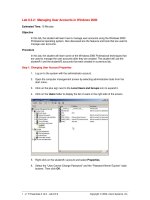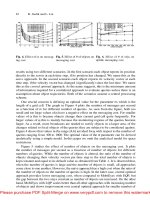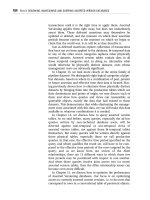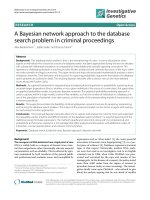Keyword Search in Databases- P3 docx
Bạn đang xem bản rút gọn của tài liệu. Xem và tải ngay bản đầy đủ của tài liệu tại đây (110.47 KB, 5 trang )
Preface
It has become highly desirable to provide flexible ways for users to query/search information by
integrating database (DB) and information retrieval (IR) techniques in the same platform. On one
hand, the sophisticated DB facilities provided by a database management system assistusers to query
well-structured information usingaquery language based ondatabaseschemas.Such systems include
conventional
rdbmss (such as DB2, ORACLE, SQL-Server), which use sql to query relational
databases (RDBs) and XML data management systems, which use XQuery to query XML databases.
On the other hand, IR techniques allow users to search unstructured information using keywords
based on scoring and ranking, and they do not need users to understand any database schemas. The
main research issues on DB/IR integration are discussed by Chaudhuri et al. [2005] and debated in
a SIGMOD panel discussion [Amer-Yahia et al., 2005]. Several tutorials are also given on keyword
search over RDBs and XML databases, including those by Amer-Yahia and Shanmugasundaram
[2005]; Chaudhuri and Das [2009]; Chen et al. [2009].
The main purpose of this book is to survey the recent developments on keyword search over
databases that focuses on finding structural information among objects in a database using a keyword
query that is a set of keywords. Such structural information to be returned can be either trees or sub-
graphs representing how the objects, which contain the required keywords, are interconnected in an
RDB or in an XML database.In this book, we call this structural keyword search or,simply,keyword
search. The structural keyword search is completely different from finding documents that contain
all the user-given keywords. The former focuses on the interconnected object structures, whereas
the latter focuses on the object content. In a DB/IR context, for this book, we use keyword search
and keyword query interchangeably.We introduce forms of answers, scoring/ranking functions, and
approaches to process keyword queries.
The book is organized as follows.
In Chapter 1, we highlight the main research issues on the structural keyword search in
different contexts.
In Chapter 2, we focus on supporting keyword search in an
rdms using sql. Since this implies
making use of the database schema information to issue
sql queries in order to find structural
information for a keyword query, it is generally called a schema-based approach. We concentrate on
the two main steps in the schema-based approach, namely, how to generate a set of
sql queries that
can find all the structural information among tuples in an RDB completely and how to evaluate the
generated set of
sql queries efficiently. We will address how to find all or top-k answers in a static
RDB or a dynamic data stream environment.
In Chapter 3,we also focus on supporting keyword search in an
rdbms.Unlike the approaches
discussed in Chapter 2 using
sql, we discuss the approaches that are based on graph algorithms by
xii PREFACE
materializing an entire database as a large data graph.This type of approach is called schema-free, in
the sense that it does not request any database schema assistance. We introduce several algorithms,
namely polynomial delay based algorithms, dynamic programming based algorithms, and Dijkstra
shortest path based algorithms. We discuss how to find exact top-k and approximate top-k answers
in a large data graph for a keyword query. We will discuss the indexing mechanisms and the ways to
handle a large graph on disk.
In Chapter 4,wediscusskeyword search in an XML database where an XML database is a large
data tree. The two main issues are how to find all subtrees that contain all the user-given keywords
and how to identify the meaning of such returned subtrees.We will discuss several algorithms to find
subtrees based on lowest common ancestor (
LCA) semantics, smallest LCA semantics, exclusive
LCA semantics, etc.
In Chapter 5, we highlight several interesting research issues regarding keyword search on
databases. The topics include how to select a database among many possible databases to answer a
keyword query, how to support keyword query in a spatial database, how to rank objects according to
their relevance to a keyword query using PageRank-like approaches, how to process keyword queries
in an OLAP (On-Line Analytical Processing) context, how to find frequent additional keywords
that are most related to a keyword query, how to interpret a keyword query by showing top-k
sql
queries, and how to project a small database that only contains objects related to a keyword query.
The book surveys the recent developments on the structural keyword search. The book can
be used as either an extended survey for people who are interested in the structural keyword search
or a reference book for a postgraduate course on the related topics.
We acknowledge the support of our research on keyword search by the grant of the Research
Grants Council of the Hong Kong SAR, China, No. 419109.
We are greatly indebted to M.Tamer Özsu who encouraged us to write this book and provided
many valuable comments to improve the quality of the book.
Jeffrey Xu Yu, Lu Qin, and Lijun Chang
The Department of Systems Engineering and Engineering Management
The Faculty of Engineering
The Chinese University of Hong Kong
December, 2009
1
CHAPTER 1
Introduction
Conceptually, a database can be viewed as a data graph G
D
(V , E), where V represents a set of
objects, and E represents a set of connections between objects. In this book, we concentrate on two
kinds of databases, a relational database (RDB) and an XML database. In an RDB, an object is a
tuple that consists of many attribute values where some attribute values are strings or full-text; there
is a connection between two objects if there exists at least one reference from one to the other. In
an XML database, an object is an element that may have attributes/values. Like RDBs, some values
are strings.There is a connection (parent/child relationship) between two objects if one links to the
other. An RDB is viewed as a large graph, whereas an XML database is viewed as a large tree.
The main purpose of this book is to survey the recent developments on finding structural in-
formation among objects in a database using a keyword query, Q, which is a set of keywords of size l,
denoted as Q ={k
1
,k
2
, ··· ,k
l
}.Wecallitanl-keyword query.The structural information to be re-
turned for an l-keyword query can be a set of connected structures,
R ={R
1
(V , E), R
2
(V , E), ···}
where R
i
(V , E) is a connected structure that represents how the objects that contain the required
keywords, are interconnected in a database G
D
. S can be either all trees or all subgraphs. When
a function score(·) is given to score a structure, we can find the top-k structures instead of all
structures in the database G
D
.Suchascore(·) function can be based on either the text information
maintained in objects (node weights) or the connections among objects (edge weights), or both.
In Chapter 2,wefocusonsupporting keyword search in an
rdbms using sql.Sincethisimplies
making use of the database schema information to issue
sql queries in order to find structures for an
l-keyword query, it is called the schema-based approach. The two main steps in the schema-based
approach are how to generate a set of
sql queries that can find all the structures among tuples in an
RDB completely and how to evaluate the generated set of
sql queries efficiently. Due to the nature
of set operations used in
sql and the underneath relational algebra,a data graph G
D
is considered as
an undirected graph by ignoring the direction of references between tuples, and, therefore, a returned
structure is of undirected structure (either tree or subgraph).The existing algorithms use a parameter
to control the maximum size of a structure allowed. Such a size control parameter limits the number
of
sql queries to be executed. Otherwise, the number of sql queries to be executed for finding all
or even top-k structures is too large.The score(·) functions used to rank the structures are all based
on the text information on objects. We will address how to find all or top-k structures in a static
RDB or a dynamic data stream environment.
In Chapter 3,we focus on supporting keyword search in an
rdbms from a different viewpoint,
by treating an RDB as a directed graph G
D
. Unlike an undirected graph, the fact that an object v
can reach to another object u in a directed graph does not necessarily mean that the object v is
2 1. INTRODUCTION
reachable from u. In this context, a returned structure (either steiner tree, distinct rooted tree, r-
radius steiner graph, or multi-center subgraph) is directed. Such direction handling provides users
with more information on how the objects are interconnected. On the other hand, it requests higher
computational cost to find such structures. Many graph-based algorithms are designed to find top-
k structures, where the score(·) functions used to rank the structures are mainly based on the
connections among objects. This type of approach is called schema-free in the sense that it does
not request any database schema assistance. In this chapter, we introduce several algorithms, namely
polynomial delay based algorithms, dynamic programming based algorithms, and Dijkstra shortest
path based algorithms. We discuss how to find exact top-k and approximate top-k structures in G
D
for an l-keyword query. The size control parameter is not always needed in this type of approach.
For example, the algorithms that find the optimal top-k steiner trees attempt to find the optimal
top-k steiner trees among all possible combinations in G
D
without a size control parameter.We also
discuss the indexing mechanisms and the ways to handle a large graph on disk.
In Chapter 4, we discuss keyword search in an XML database where an XML database is
considered as a large directed tree. Therefore, in this context, the data graph G
D
is a directed tree.
Such a directed tree may be seen as a special case of the directed graph, so that the algorithms
discussed in Chapter 3 can be used to support l-keyword queries in an XML database. However, the
main research issue is different.The existing approaches process l-keyword queries in the context of
XML databases by finding structures that are based on the lowest common ancestor (
LCA)ofthe
objects that contain the required keywords. In other words, a returned structure is a subtree rooted
at the
LCA in G
D
that contains the required keywords in the subtree, but it is not any subtree
in G
D
that contains the required keywords in the subtree. The main research issue is to efficiently
find meaningful structures to be returned. The meaningfulness are not defined based on score(·)
functions.Algorithms are proposed to find smallest
LCA,exclusive LCA, and compact LCA,which
we will discuss in Chapter 4.
In Chapter 5, we highlight several interesting research issues regarding keyword search on
databases. The topics include how to select a database among many possible databases to answer
an l-keyword query, how to support l-keyword queries in a spatial database, how to rank objects
according to their relevance to an l-keyword query using PageRank-like approaches, how to process
l-keyword queries in an OLAP (On-Line Analytical Processing) context, how to find frequent
additional keywords that are most related to an l-keyword query, how to interpret an l-keyword
query by showing top-k
sql queries, and how to project a small database that only contains objects
related to an l-keyword query.
3
CHAPTER 2
Schema-Based Keyword Search
on Relational Databases
In this chapter, we discuss how to support keyword queries in a middleware on top of a rdbms
or on a rdbms directly using sql. In Section 2.1, we start with fundamental definitions such as, a
schema graph, an l-keyword query, a tree-structured answer that is called a minimal total joining
network of tuples and is denoted as MTJNT , and ranking functions. In Section 2.2, for evaluating
an l-keyword query over an RDB, we discuss how to generate query plans (called candidate network
generation), and in Section 2.3, we discuss how to evaluate query plans (called candidate evaluation).
In particular, we discuss how to find all MTJNT s in a static RDB and a dynamic RDB in a data
stream context, and we discuss how to find top-k MTJNT s. In Section 2.4, in addition to the tree-
structured answers (MTJNT s) to be found, we discuss how to find graph structured answers using
sql on rdbms directly.
2.1 INTRODUCTION
We consider a relational database schema as a directed graph G
S
(V , E), called a schema graph,where
V represents the set of relation schemas {R
1
,R
2
, ··· ,R
n
} and E represents the set of edges between
two relation schemas. Given two relation schemas, R
i
and R
j
, there exists an edge in the schema
graph,from R
i
to R
j
,denoted R
i
→ R
j
,if the primary key defined on R
i
is referenced by the foreign
key defined on R
j
.There may exist multiple edges from R
i
to R
j
in G
S
if there are different foreign
keys defined on R
j
referencing the primary key defined on R
i
. In such a case, we use R
i
X
→ R
j
,
where X is the foreign key attribute names. We use V(G
S
) and E(G
S
) to denote the set of nodes
and the set of edges of G
S
, respectively. In a relation schema R
i
, we call an attribute, defined on
strings or full-text, a text attribute, to which keyword search is allowed.
A relation on relation schema R
i
is an instance of the relation schema (a set of tuples) con-
forming to the relation schema, denoted r(R
i
). We use R
i
to denote r(R
i
) if the context is obvious.
A relational database (RDB) is a collection of relations.We assume, for a relation schema, R
i
, there is
an attribute calledTID (Tuple ID), a tuple in r(R
i
) is uniquely identified by a TID value in the entire
RDB.InORACLE, a hidden attribute called rowid in a relation can be used to identify a tuple in an
RDB, uniquely. In addition, such a TID attribute can be easily supported as a composite attribute
in a relation, R
i
, using two attributes, namely, relation-identifier and tuple-identifier. The former
keeps the unique relation schema identifier for R
i
, and the latter keeps a unique tuple identifier in









